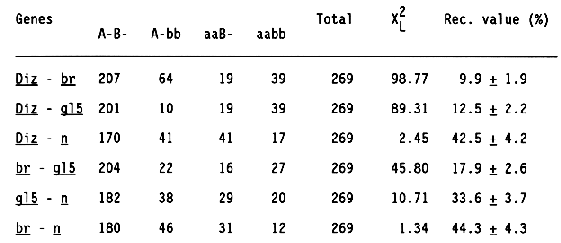

In the previous paper (Takeda, 1987), the author reported that about 700 varieties of ca. 5,000 world barley cultivars are sensitive to an insecticide, diazinon (an organic phosphate), when the seedlings are sprayed with 1,000-2,000 ppm solution of diazinon and kept at low temperature and natural light condition. The frequency of the sensitive varieties are high (up to 50%) in the western Asia, but none in eastern Asia. As the diazinon sensitivity itself is free from the natural selection, it is a useful marker to study the phylogenetical differentiation between the Oriental and the Occidental barley varieties.
The diazinon sensitivity is controlled by a single dominant gene, named Diz (diazinon sensitivity) and all the sensitive genes tested so far are allelic (Table 1).
To determine the linkage relation of Diz, several linkage testers were crossed with a diazinon sensitive variety, "Ethiopia 90" (Accession No. OUE 630). Diz was independent of the following markers: v (kernel rows) and e (wide outer glume) on chromosome 2; uz "uzu" semi-brachytic) and al (albino lemma) on chromosome 3; gsl (glossy sheath) on chromosome 4; trd (third outer glume) and B (black lemma and pericarp) on chromosome 5; and cud (curly dwarf) on chromosome 7. Markers on chromosome 6 were not tested, but Diz was linked with such markers on chromosome 1 as n (naked kernel), gl5 (glossy leaf) and br (brachytic).
An F2 population derived from a cross between OUL 135 (diz, br, gl5, n) and OUE 630 (Diz, Br, Gl5, N) was examined to determine the linkage relationship of the genes on chromosome 1. According to the F2 data shown in Table 2, Diz was inserted between br and gl5 on the short arm of chromosome 1 (Figure 1). Diz may be a new and useful physiological marker in barley.



Reference:
Takeda, K. 1987. Geographical distribution of diazinon sensitive varieties in barley. BGN 17:90-91.